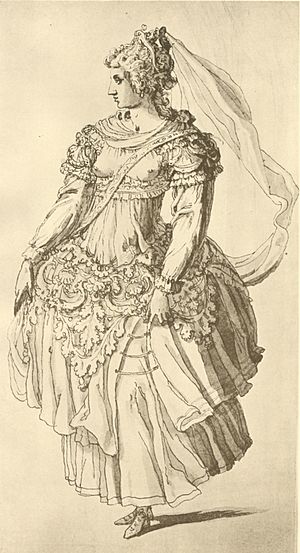Christopher Shawe facts for kids
Christopher Shawe (died 1618) was a talented English embroiderer and textile artist. He was known for creating amazing costumes, especially for the masques performed for Anne of Denmark, who was the queen at the time. He was also a member of a special group called the Worshipful Company of Broderers, which was like a guild for embroiderers.
Contents
Who Was Christopher Shawe?
Christopher Shawe was a skilled artist who worked with fabrics and threads. An embroiderer creates designs on cloth using needles and different colored threads. A textile artist works with various materials like fabric, yarn, and thread to make art. Shawe was very good at both!

Working for the Queen
Shawe created many beautiful costumes for Queen Anne of Denmark. She loved to put on special shows called masques. A masque was a type of play or performance with music, dancing, and elaborate costumes, often performed by members of the royal family and nobles.
In December 1603, Shawe worked on costumes for a masque called The Vision of the Twelve Goddesses. Some of these costumes were even made from old clothes that belonged to Elizabeth I, the queen before Anne.
Later, in January 1608, Shawe was paid a large sum of money for his work on costumes for The Masque of Beauty. He also made costumes for another big masque in 1610 called Tethys' Festival. We know a lot about his work for this masque because his detailed bill still exists today!
Costumes for Tethys' Festival
For Tethys' Festival, Shawe embroidered delicate "cobweb silver lawn" fabric with silver and sea-green silk. He also sewed on shiny silver and gold decorations called "oes." He even embroidered a pair of sea-green satin dancing shoes!
The queen herself wore these special costumes and shoes. She played the role of Tethys, a sea goddess from ancient Greek myths. Her ladies-in-waiting played characters representing rivers. A drawing by the famous designer Inigo Jones shows a costume for Tethys or a nymph with "shoes of satin, richly imbrodered," which might be one of Shawe's creations.
The "cobweb lawn" fabric was very fine linen, perfect for making light, flowing veils. Queen Anne owned many beautiful mantles (like cloaks) made from similar lightweight fabrics.
Shawe was not always paid on time for his work. He had to ask for his payment for the masque costumes and other embroidery he did for the queen.
Christopher Shawe passed away on July 31, 1618. He was buried in a churchyard in Chipstead, where a special stone remembers him as a citizen of London and an "Imbrodorer."
Helping Others
In his will, which is a document stating what happens to a person's belongings after they die, Christopher Shawe showed his generous spirit. He left money to help the poor people in his local village of Chipstead. This money was given out as bread.
He also left money to the schoolmaster at Market Harborough. This shows he cared about education and helping his community. He even made sure money was given to the poor on November 5th each year, to remember the discovery of the Gunpowder Plot.
His Family's Legacy
Christopher Shawe had two daughters and three sons. One of his sons, also named Christopher Shawe, followed in his father's footsteps. Christopher Shawe the younger also worked as an embroiderer for Queen Anne of Denmark.
After the younger Christopher Shawe died, his wife, Margaret Shawe, had to ask for payment for the work he had done for the queen. She had three young children at the time, and the money was very important for her family.

